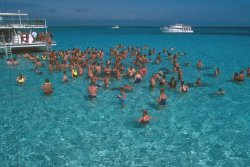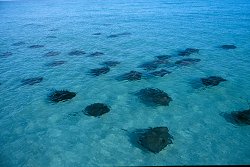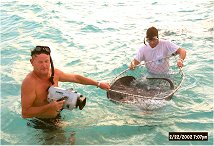Research
Stingray Conservation and Ecology Research
 The Cayman Islands are home to two of the world's best known dive and snorkel sites, Stingray City and the Sandbar, where large numbers of southern stingrays (Dasyatis americana) aggregate in response to feeding by dive operators. These sites attract nearly half a million visitors per year from around the world who enjoy a unique educational experience interacting with these charismatic animals.
The Cayman Islands are home to two of the world's best known dive and snorkel sites, Stingray City and the Sandbar, where large numbers of southern stingrays (Dasyatis americana) aggregate in response to feeding by dive operators. These sites attract nearly half a million visitors per year from around the world who enjoy a unique educational experience interacting with these charismatic animals.
 There are concerns, however, that extensive human interaction and supplemental feeding almost daily may be having subtle negative impacts on the behavior and general ecology of the stingrays. Maintaining the biological health of these stingray populations for the long-term will require management and conservation programs based on a thorough knowledge of the biology of these animals.
There are concerns, however, that extensive human interaction and supplemental feeding almost daily may be having subtle negative impacts on the behavior and general ecology of the stingrays. Maintaining the biological health of these stingray populations for the long-term will require management and conservation programs based on a thorough knowledge of the biology of these animals.
To gain a better understanding of stingray biology and aid in conservation efforts, scientists at the NSU Guy Harvey Research Institute are conducting research on the behavior, reproduction, genetics and population characteristics of the southern stingrays in the Cayman Islands and Caribbean.
Stingray Project Results to Date
 Six months of tagging data indicate a population size of 144 -147 stingrays at the Sandbar, with females almost six times more abundant than males.
Six months of tagging data indicate a population size of 144 -147 stingrays at the Sandbar, with females almost six times more abundant than males.
- Examination of reproductive characteristics indicates that pregnant females are found from at least February to September at the Sandbar.
- Analysis of length of male reproductive appendages (claspers) relative to size of males (disc width) indicates that males become reproductively mature at 47 cm disc size (see graph).
- Female southern stingrays mate with multiple males, as revealed by underwater video documentation of mating behavior in this species. For a sequence of mating events in the wild, please download our Stingray mating video.
- Preliminary data obtained from tracking the stingrays with ultrasonic transmitters at the Sandbar and Stingray City indicate that males move over larger ranges than females (See movement tracks).
- Initial comparison of movement patterns of human fed stingrays with unfed stingrays shows some evidence that unfed animals may have larger movement ranges than fed animals.
- Preliminary analysis of stingray DNA suggests that the Cayman stingrays are more closely related to stingrays from the Bahamas and Antigua than to Belize animals.
The stingray research project will be continued over two years to confirm the above observations and collect additional information for conservation efforts. New studies will include longer-term monitoring of animal movement patterns and a more detailed assessment of the genetic uniqueness of the Cayman Island stingrays relative to other Caribbean Islands